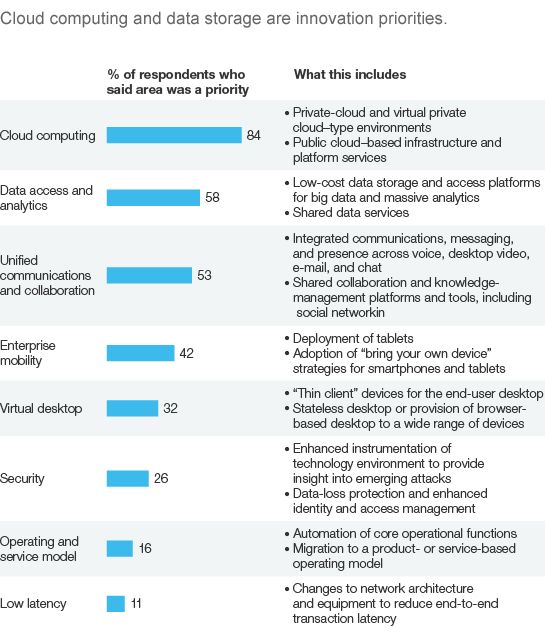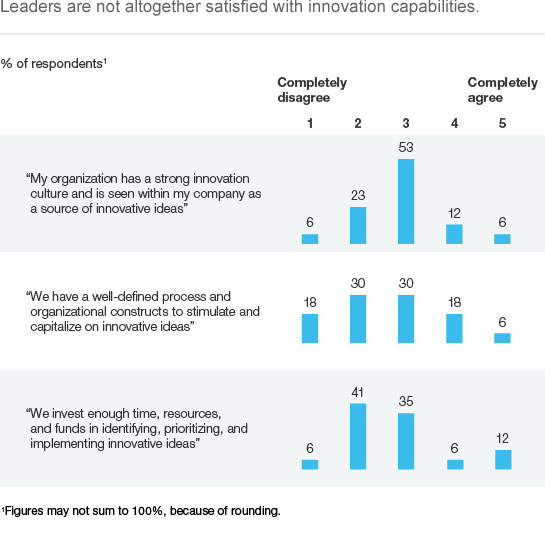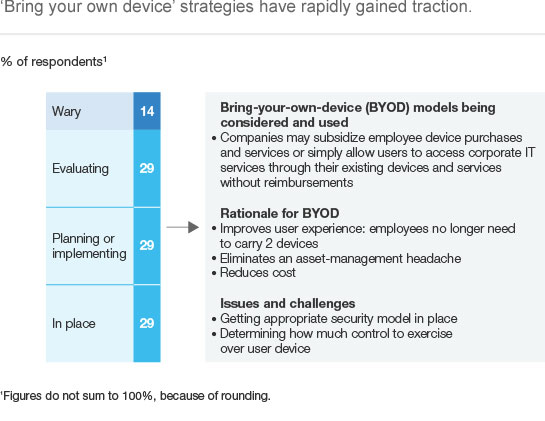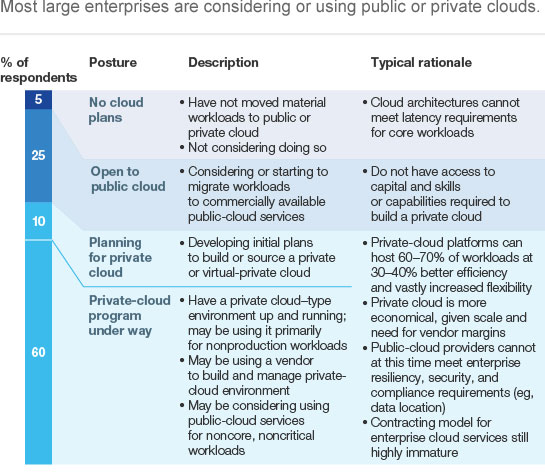Innovation is a critical part of the mandate for enterprise infrastructure functions. When we interviewed senior infrastructure executives about their innovation priorities and capabilities,1 many emphasized that constant innovation represented their only chance of meeting user expectations while supporting—within budgetary constraints—ever-increasing business demands for computation, data storage, and connectivity.
Cloud computing was the most prevalent innovation theme among the executives we interviewed (Exhibit 1). But many infrastructure organizations are also aggressively seeking to support data analytics and provide richer end-user experiences. What’s more, many of the infrastructure functions responsible for security technology are prioritizing investments in ways that will better secure their environments from cyberattacks.

However, most leaders of infrastructure functions appear less than satisfied with their units’ ability to innovate. While they report significant progress over the past few years, most say their organizations do not have a repeatable process for extracting value from innovation and do not devote enough resources to it compared with running day-to-day operations. Moreover, many IT functions are not seen within the company as a source of innovation (Exhibit 2).

This article presents seven key findings on how infrastructure leaders view their innovation priorities and how they are managing their organizations and vendor relationships to support their agendas.
1. Innovation is more than just technology
Almost all infrastructure leaders described innovation not as the introduction of new technologies but as “new ways of doing things” when providing service and conducting day-to-day operations for their organizations. While many of these leaders summarized their innovation agendas using technological terms like cloud computing or desktop virtualization, they point out that selecting the right technologies is only half the job. Integrating technologies into services that meet business-user needs and building scalable processes for provisioning and support represent the more complicated and challenging part of capturing value from innovation.
In addition, some infrastructure organizations have an innovation agenda that is more operational than technological. They are focusing on changing their interaction model with the business, making end-to-end processes lean, and automating critical functions like change and event management.
2. Cloud computing is transitioning to the mainstream
There is more agreement on the importance of cloud computing than on its definition.
Roughly five out of six large infrastructure organizations list cloud computing as one of their top innovation priorities over the next couple of years, and nearly all have a cloud-computing program or are starting to develop plans to put one in place. While leaders emphasized that cloud computing did not necessarily mean procuring publicly available services, they drew no clear dividing line between a highly virtualized server environment and a “private cloud” environment. Defining characteristics cited by infrastructure leaders included one-touch provisioning, end-to-end automation, stateless servers, converged technologies, and dynamic capacity reallocation based on business rules. Infrastructure executives voiced a fair bit of discomfort with how cloud computing has been presented in the business and trade press. Several described their private-cloud programs as the natural continuation of years of consolidating, standardizing, virtualizing, and automating their server environments. A few infrastructure leaders described “cloud” as a “marketecture” term and said they preferred to talk about “utility computing” or “virtualization 3.0.”
That said, the largest infrastructure functions, particularly in heavily regulated industries like banking and pharmaceuticals, plan to build private-cloud environments over the next three to five years rather than procure publicly available cloud services. Why? As might be expected, there are concerns about application availability, data security, and regulatory compliance. Several infrastructure leaders said that they believed public-cloud providers have not yet developed the capabilities required by the most complex infrastructure functions. Data location, for example, is a key regulatory requirement. One infrastructure head said, “We have data that can’t leave the United States, and we have data that have to stay in Europe, but we haven’t seen how the public providers can support that.” Other infrastructure heads pointed out that the process of contracting for enterprise cloud services was not yet mature and that the contractual terms and conditions required for a successful agreement would only emerge over time through trial and error. (See sidebar, “Building a private cloud.”)
A few infrastructure organizations, especially those with annual budgets in the hundreds of millions rather than billions of dollars, did express openness to using public-cloud offerings for infrastructure services. Infrastructure leaders considering this option believed that they could not get top-management support for the capital required to build out a private-cloud environment and did not believe they had the skills and talent in their organizations to manage a private-cloud program. In some cases, they saw the use of public-cloud services potentially leading to a fundamental shift, with the infrastructure organization becoming much more of a vendor-management and governance function for external services selected and paid for by business unit IT.
3. The path to end-user productivity is still evolving
With cloud programs that can improve data-center capability and efficiency under way, infrastructure organizations are also starting to enhance their focus on enabling end-user productivity. Three of the five most common innovation priorities cited by IT infrastructure executives relate to end-user productivity: unified communications and collaboration, virtual-desktop services, and enterprise mobility. There are a number of reasons for this enhanced productivity focus. Technology-savvy employees are increasingly capable of using productivity tools effectively and are more and more confident about demanding tools that meet their needs. Highly functional, easy-to-use, and low-cost (or free) consumer-oriented tools like Dropbox, Facebook, and Skype raise users’ expectations. At many companies, the most critical employees (in functions such as sales, marketing, research, and design) depend on end-user technology tools rather than business applications to enhance their productivity.
Despite the increasing focus on end-user productivity, there is much less consensus on what steps to take and what the value proposition will be than there is for cloud computing. Some organizations are implementing unified-communications platforms (integrating chat, e-mail, knowledge management, video, and voice for a seamless user experience) based on expectations that they will facilitate employee productivity. Others have not been able to make the business case to senior management. Some organizations are incorporating desktop video into their unified-communications plans; others do not believe that it justifies incremental bandwidth costs. Some organizations focus unified communications on chat, video, and voice. Others plan to integrate collaboration and knowledge-management capabilities tightly. Some organizations are partially funding unified-communications investments by removing telephone handsets from user desktops; others say their users will never stand for that.
Perspectives are similarly split on how to deploy virtual-desktop services, which separate the end-user “desktop” environment from a physical machine and can potentially simplify support, improve data security, and allow users to access their desktops from a range of devices. Most infrastructure leaders report good experiences with early virtual-desktop deployments and believe that they offer flexibility and security advantages that a traditional desktop environment cannot match. Much less consensus, however, exists about the economics of virtual desktops. Some infrastructure leaders report savings of 30 percent compared with traditional environments because of lower costs for moving, adding, or changing desktop equipment and providing user support. They therefore plan to migrate much of their user base to virtual-desktop services over time. Others see virtual desktops costing about the same as or a little bit more than traditional ones because of back-end hosting costs and therefore plan to limit virtual-desktop services to targeted user segments. It seems that the difference between these perspectives stems from variations in virtual-desktop solutions (for example, how much storage is allocated to each user) and the efficiency of back-end hosting.
4. ‘Bring your own device’ is quickly gaining traction
About 30 percent of large IT infrastructure functions enable users to access enterprise services via their personal devices, and 60 percent are either evaluating or putting in place a “bring your own device” (BYOD) program (Exhibit 3). To date, these are almost entirely focused on allowing employees to use their own smartphones and tablet devices.

BYOD strategies have gained traction so rapidly because they exploit an alignment of employee and company interests. Users no longer have to carry multiple devices (for example, corporate and personal smartphones) and get more flexibility in selecting devices that meet their needs. Institutions no longer have the headache of supporting and tracking small, relatively low-cost devices that are easily broken or lost.
In a few cases, infrastructure organizations have seen savings that can amount to hundreds of dollars a year per employee by no longer procuring devices and services that duplicate ones that the employees buy for personal use. Even without subsidies, there seem to be a significant number of employees who would still take advantage of the service. One institution launched a voluntary pilot that did not include subsidies but was nevertheless quickly oversubscribed.
Most of the executives we interviewed are at some stage of planning and implementing programs to replace their corporate BlackBerry and mobile-phone support with a BYOD program. In almost all cases, the program is voluntary for employees, and uptake has been greater than expected. These programs most commonly provide e-mail and calendar synchronization for iPad and iPhone devices.
Several interviewees are considering leveraging virtual-desktop technology to extend BYOD programs to laptops and desktops, though none of the infrastructure groups we surveyed had rolled this out at scale. In part, they are considering doing so because they have users who work from home, and BYOD programs would eliminate the cost and complexity of managing devices in employees’ homes.
5. Proactive engagement with business is required
Roughly half of all large infrastructure organizations manage innovation in a reactive way: innovation occurs in response to business requests and in support of business projects. While this model reduces the risk of innovation that is not relevant to business needs, it also makes it harder to get in front of business needs and to drive cross-cutting innovations across business units.
However, being credible as an innovator requires that infrastructure organizations understand underlying business needs and bring proposals for possible innovations to business and application leaders. Two organizational constructs have been helpful in accomplishing this:
-
A few infrastructure groups have set up small organizations, with funding, to work directly with business owners on figuring out ways to leverage technology in solving business problems and transforming go-to-market approaches. At least one is seeing fairly substantial change and impact in how the company engages its customers at branch sites through the use of wireless technology.
-
Others have created product-driven models, in which infrastructure product managers oversee an overall road map for end-user services or application hosting that integrates innovation initiatives with more tactical investments, for example, in expanding capacity and refreshing technology assets. This model enables infrastructure organizations to innovate much more proactively, but it also requires a constructive working relationship with business-unit IT for success.
In addition, some infrastructure functions have managed to be proactive at innovation—without creating specific processes or organizational constructs—by creating space for talented staff to focus on innovation. A couple of companies hold “hackathons” where for a day (or night) staff will form small teams on topics that are outside their typical day-to-day activities and build solutions that improve performance.
Moreover, despite the wide range of funding models in use, most participants finance innovation as part of the regular investment process. In most places, dedicated innovation funds or budgets are limited to small investments for proof-of-concept activities.
6. Getting the right talent is increasingly critical
Getting the right skills, mind-sets, and capabilities in place is critical to any ambitious innovation agenda. Many infrastructure leaders note that it is quite tough to find managers with the combination of deep technology knowledge, commercial insight, communication skills, and creative problem-solving skills to drive innovation initiatives. A few leaders pointed out that their organizations could introduce only one or two real innovations per year because they had to be personally involved to ensure success.
Infrastructure organizations are experimenting with a variety of levers to overcome these challenges and build the talent required for innovation:
-
Empowering engineers by expanding their decision-making authority. They allow, for example, engineers to decide independently when to roll out a new feature and what group to test it with (choosing from internal users only, a small subset of users, a large subset, or all users). Companies can also give engineers and other technical staff time to experiment with new ideas.
-
Reducing risk aversion by supporting both failures and successes. These organizations communicate that it is acceptable to spend time on an effort that does not work out in the end. In parallel, they emphasize the importance of “failing fast” by testing new ideas early and rigorously.
-
Leveraging nontraditional talent. They bring new ideas, perspectives, and approaches into infrastructure organizations. Hiring managers from application development brings insights about what development teams need to the heart of the infrastructure organization. Hiring managers from high-technology vendors brings insights about leading-edge technologies and commercial product-development processes.
7. Vendor relationships must focus on innovation
Almost all infrastructure leaders said that technology vendors’ insights and capabilities were critical for their innovation efforts, and many noted that they had to collaborate with vendors on technology road maps in order to have a chance of success. As one infrastructure leader noted, “My technology strategy depends on products that haven’t been invented yet. I have to understand what my most strategic vendors are developing and find ways to influence their product road maps.”
However, most infrastructure leaders thought it was easier said than done to collaborate closely with vendors. Many senior infrastructure executives pointed out that outsourcing arrangements can be a barrier to infrastructure innovation. For instance, contract terms can complicate the introduction of new technologies and services if the vendor has invested heavily in existing service models. What’s more, outsourced staff may have less insight into and connection with business needs—insights and connections that can drive innovation powerfully.
In other cases, infrastructure leaders said it was hard to get past vendor sales teams to speak with vendor thought leaders about particular technologies. Another occasional hurdle was that sales teams tried to work with application developers to introduce technologies that either could not be supported or did not align with the company’s technology. A few infrastructure leaders also expressed concerns that vendors devoted too much of their development resources to incremental features rather than advances at the underlying level.
Internal procurement processes and policies can also get in the way of collaborating with vendors. There is sometimes a basic disconnect between a mind-set that drives a transactional, price-oriented relationship among vendors and enterprises and the need to place strategic vendor bets that have implications for several generations of technology over many years.
Many infrastructure leaders feel they do not have the right incentives in place for large, traditional vendors to bring truly innovative ideas to the table unless the idea has clear potential for driving more business for the vendor. Infrastructure functions are exploring different models that can break the impasse:
-
Explicit agreements. Some organizations have built into their vendor agreements the need to bring innovations to the table. This model is more common in mature and well-understood areas that are outsourced in a managed-service model—for example, end-user deskside support.
-
Innovation labs. One company has created a lab where vendors can petition to set up technology environments (for instance, a storage or hosting solution) that are benchmarked against the current standards. If vendors can prove that their solution is better (with regard to performance, quality, usability, or cost) than what exists, the solution can be promoted into operational environments.
-
Codevelopment with small vendors. While small vendors often lack the scale to support enterprise environments, they are typically quite responsive and flexible. Several companies are for that reason targeting parts of their technology road map for codevelopment with smaller, highly innovative vendors.
Leaders of IT infrastructure functions face a formidable innovation challenge. To make the most of technology opportunities like cloud computing, unified communications, mobility, and virtual desktops, these leaders must integrate technology with new services and processes that meet business-user needs. That means engaging proactively with the business side, finding the right talent, and building vendor relationships that support innovation.


